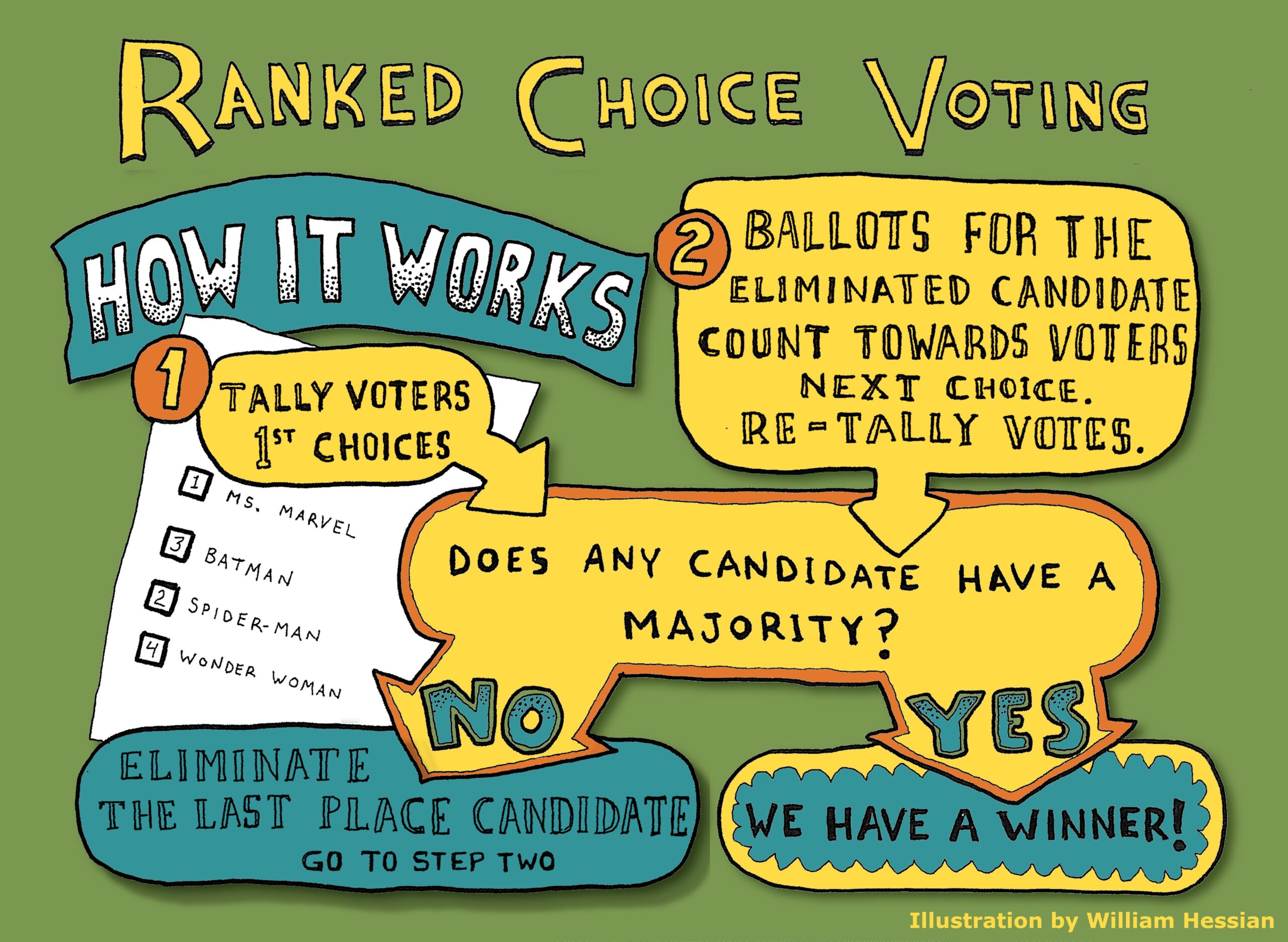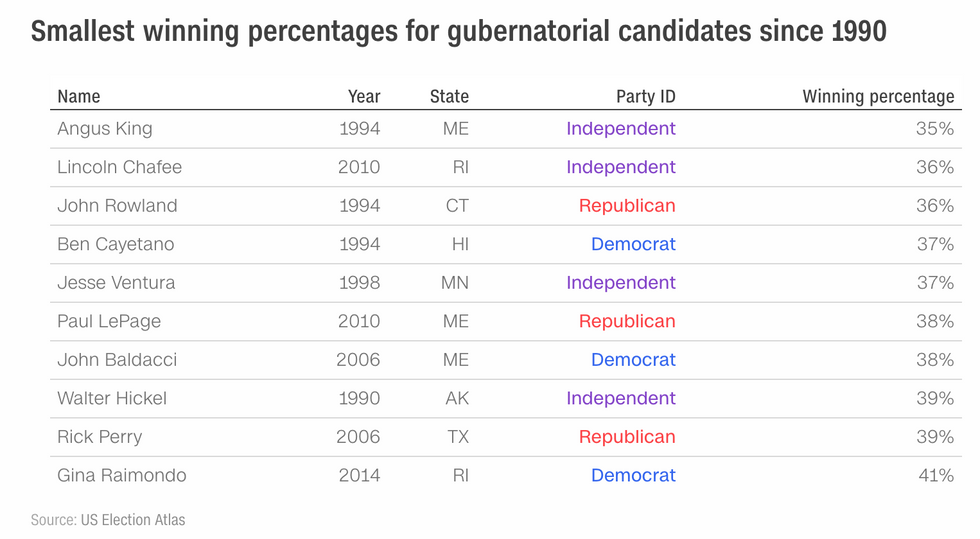Maine will officially become the first-ever state to use ranked-choice voting for a presidential election, the state’s Supreme Court ruled this September.
This will allow voters to rank each presidential candidate in order of preference for the November election. Voters will now be able to rank all five presidential candidates that will appear on the ballot, which include Republican President Donald Trump, Democrat Joe Biden, Libertarian Jo Jorgensen, Green Party candidate Howard Hawkins, and Rocky De La Fuente of the Alliance Party. But why is ranked choice voting such a big deal?
How Does It Work?
Ranked Choice Voting is also known as instant-runoff voting (IRV), the alternative vote (AV), or preferential voting. In ranked choice voting, instead of only voting for one candidate, voters can rank the candidates in order of preference. You can rank as many or as few of the candidates as you like and leave the rest blank. If any candidate has more than half of the vote based on first-choices, that candidate wins. If not, then the candidate with the fewest votes is eliminated and their votes are redistributed to their second-choices. The process repeats until one candidate has a majority.
Former Massachusetts gubernatorial candidate, Evan Falchuk, explains that ranked choice voting is essentially the same idea as runoff elections. “You hold an election one day, and then you see how the votes come out, and then you eliminate the candidates that didn’t meet whatever the threshold is, and then you hold another election. With ranked choice voting, you do that instantaneously,” he stated. Maine’s new policy is essentially a more efficient way to hold multiple rounds of elections at the same time.
 Ranked Choice VotingWilliam Hessian
Ranked Choice VotingWilliam Hessian
This system was successfully used by all voters in four states in the 2020 Democratic Party presidential primaries, and is used for local elections in more than 15 US cities and the state of Maine. Even some of the biggest critics of RCV agree it’s better than our current system.
But what does this mean for elections? Elections have become increasingly unreliable at selecting policymakers who are representative of and supported by their constituents. But RCV eliminates a few of the common problems that exist in our current system. It makes third parties viable, it enables winners that have majority support, and it reduces polarization and negative campaigning.
Benefit # 1: RCV Makes 3rd Parties Viable
The majority of the country uses a system called winner-take-all voting or first-past-the-post voting. In this system, voters each have a single vote which they can cast for a single candidate. Whoever gets a plurality of the votes wins all of the representation. Winner-take-all voting systems naturally trend towards two parties. This is mainly because voters feel that they have to strategically vote for candidates who have the best chance of winning so that they don’t “waste their vote.”
Yet third parties still run for president every four years, and every four years they lose. Sometimes they gain a fair amount of votes, but even then, they are accused of being spoilers.
The spoiler effect is when a third-party candidate’s presence in the election draws votes from a major-party candidate similar to them, thereby causing a candidate dissimilar to them to win the election. The more popular a third-party candidate, the less likely someone who has similar beliefs is to win.
 The Spoiler Effect@The_Factivists
The Spoiler Effect@The_Factivists
The spoiler effect is particularly relevant in close elections like the 2000 presidential race. Many people think that Democrat Al Gore lost the 2000 Presidential Election to Republican George W. Bush because some voters on the left voted for Ralph Nader of the Green Party. If even 1% of Nader’s Floridian supporters had chosen to vote for environmentalist Gore over Texas oilman Bush, Gore would have been elected president.
RCV eliminates this issue. Voters can feel confident voting for a third-party candidate, even one they think is unlikely to win, without fear of being a spoiler. Say you live in Maine and you think Green Party candidate Howard Hawkins is awesome, you think Joe Biden is just okay, but most of all you want Donald Trump to lose. Normally, most people would tell you to just suck it up and vote for Biden, because Howard Hawkins is never going to win and it’s more important to prevent Trump from winning. With RCV you can confidently rank Hawkins as your first choice and Biden as your second, and you can know that if Hawkins loses, your vote will still be put to good use.
This allows third parties to form and grow because voters can vote for the candidate they like the most without worrying that they will help elect the candidate they like least. If it were implemented across America, RCV may not lead to many third-party wins in the first few years, because America is firmly entrenched in a two-party system. However, RCV allows third parties to gain real footholds and eventually even majority support.
Benefit #2: RCV Enables Majority Support
One of the biggest problems with our current election system is that in order to win candidates only need a plurality of the vote, not a majority. A plurality just means that a candidate received more votes than everyone else, whereas a majority is 51%. This is not a problem when there are only two candidates, but any time there are more than two this becomes a concern.
Too often, candidates win elections despite being opposed by the majority of voters. In elections with more than two candidates, candidates can and do win even when less than half of voters support them.
This lack of majority support is part of what pushed voters in Maine towards adopting a new system. For example, in Maine, nine of the eleven gubernatorial elections between 1994 and 2014 were won with less than 50% of voters’ support. Maine governors with low winning percentages include Angus King, who won the governorship in 1994 with just 35% of the vote; John Baldacci, who won in 2006 with just 38.1% of the vote; and Paul LePage, who won in 2010 with 37.6% of the vote.
 Smallest Winning Percentages for Gubernatorial Candidates Since 1990US Election Atlas
Smallest Winning Percentages for Gubernatorial Candidates Since 1990US Election Atlas
These low percentage wins are not unique to Maine. A recent win in the Massachusetts Fourth Congressional District Democratic primary made headlines when Jake Auchincloss won with only 22.5% of the vote.
RCV has the potential to resolve these issues. With RCV, a candidate can only be declared a winner if they have received 51% of the vote. It’s true that not every voter will get to see their first choice candidates win, but a majority of voters will see a candidate they at least somewhat agree with in office. If a voter’s first choice is eliminated, their vote instantly goes to their second choice. That way, we can find out which of the top candidates has the most support.
All that being said, RCV will elect a majority winner—so long as that majority winner exists in the election. In RCV you only have to rank as many candidates as you like. This can result in something called exhausted ballots. Ballot exhaustion occurs as part of RCV when a voter has ranked only candidates that have been eliminated even though other candidates remain in the contest. For instance if your ballot just ranks the Green Party and Libertarian Party candidates, but you decided not to rank any of the major party candidates, it’s very possible that both of the candidates you voted for will be eliminated therefore your vote won’t end up counting in the final round. RCV makes a majority more likely but no single-winner voting method can guarantee a majority in every election, including RCV.
Benefit #3: Decreased Political Polarization
Americans are more polarized today than ever before. A 2019 Pew poll asked partisan voters to rate their feelings towards the opposite party on a thermometer-style scale. The results showed that Americans feel increasingly negative toward the party they oppose. In March 2016, before the election, 61% of Democrats gave Republicans a cold rating and 69% of Republicans gave Democrats a cold rating (a thermometer rating of 0-49). By 2019, those numbers had significantly increased, 79% of Democrats and 83% of Republicans rated the other party coldly.
Yet the results from the bipartisan Battleground Poll from October 2019 reported that 8 in 10 Americans say that “compromise and common ground should be the goal for political leaders.”
 Democrats and Republicans agree only to disagreeGary Markstein
Democrats and Republicans agree only to disagreeGary Markstein
Ranked choice voting could help bridge America’s widening political divide by changing how elections work. This is partly because RCV decreases negative campaigning and partisan politicking. When a politician needs second-choice votes to win, they’re incentivized to promote their policies rather than tear down their opponents. And they are incentivized to focus on the beliefs they have in common with other candidates rather than the small policy differences.
In RCV contests, candidates do best when they reach out and positively influence as many voters as possible–including those who support their opponents. This gives constituents more power and major parties less power. With RCV, candidates can’t write off any voter as “unreachable”; they must genuinely try to appeal to voters who are openly voting third party. This means that in order to gain those second-choice votes, major parties will have to look at the third parties close to them and adjust their platforms accordingly.
A 2016 study on campaign civility in local RCV elections found that voters viewed campaigns as more civil than they did in cities without RCV. The study concluded that “people in cities using preferential voting were significantly more satisfied with the conduct of local campaigns than people in similar cities with plurality elections.” They added, “People in cities with preferential voting were also less likely to view campaigns as negative, and less likely to respond that candidates were frequently criticizing each other.”
Our current voting system only does one thing well: fuel America’s two-party system, a system that is divisive, outdated, and makes voters feel like their votes don’t count. When voters feel like their votes count, they show up and they participate. In the words of Elizabeth Warren, RCV’s latest champion, “That’s a stronger democracy.”
Congratulations, Maine; this is a huge step in the right direction. Now let’s hope we see similar changes across America—before it’s too late.





